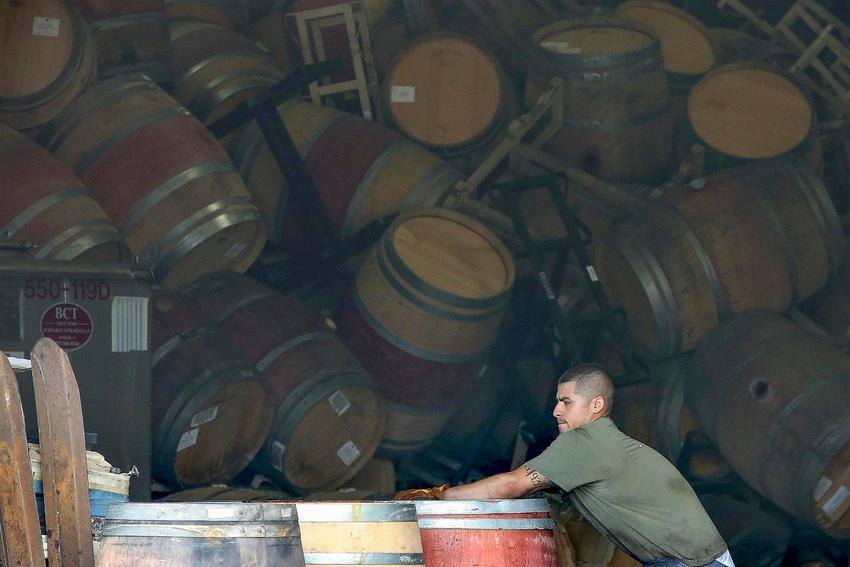
Napa’s 6.0 earthquake in late August revealed at least two things about California: seismic activity is part of life and humans can be resilient.
While estimates are quite preliminary, Napa’s famed wine industry likely suffered between $70 million and $100 million in damage from the Aug. 24 temblor, according to a report commissioned by the County of Napa and Napa County Vintners Association, a non-profit trade association.
The report was issued by Silicon Valley Bank (SVB), the dominant lender to the Napa wine industry and an expert on the global wine industry.
“While impossible to attain a precise estimate of damage, we are able to apply proprietary financial information, direct interviews with the wineries suffering the worst damage, first-hand inspections of a sample of the most impacted wineries, survey responses from more than 50 percent of Napa wineries, our own knowledge of the market, and our knowledge of the locations of the locations of inventory and production capacities of Napa wineries… in arriving at our conclusions,” writes Rob McMillan in the report.
McMillan is the executive vice president and founder of SVB’s wine division, which is based in Saint Helena, Calif. He is a noted expert on the global wine industry.
The bank’s analysis of wine industry losses is extensive. It includes damage to winery buildings and infrastructure such as waste water ponds and private bridges, winemaking equipment, cleanup and removal costs, vineyard irrigation, bottled inventory in current release, bottling supplies, finished inventory ready for bottling, bulk wine, barrels, lost revenue from damaged tasting rooms, losses from business interruption, and loss of wine held in wine libraries.
Losses could have been worse
The assessment also includes losses from stand-alone vineyard operations including machinery, supplies, cleanup costs, irrigation and piping, loss of revenue from delayed harvest, and damaged infrastructure. Those estimates could fall between $10 million and $20 million, the report says.
The report indicates that under the circumstances, losses near the epicenter “were surprisingly low due to newer building codes and the earthquake preparedness of the warehouse operators.”
Still, the report suggests that earthquake codes and safety protocols may need review after discovering significant damage at some custom crush facilities.
Because the earthquake happened at 3:20 a.m. local time on a Sunday the exposure to those in the workplace was greatly limited.
Silicon Valley Bank estimates that 60 percent of Napa County wineries sustained some degree of damage, and up to 25 percent of wineries suffered moderate to severe damage. The losses varied between $50,000 per winery to $8 million in the most devastating circumstance.
Most of the damage was in the southern and western portions of the county, including business operations in the City of Napa.
Wine grape harvest was under way in the region when the quake struck, said Steve Moulds, president of the Napa Valley Grapegrowers, a non-profit organization with over 700 members. Those harvest activities continued, even as wineries were cleaning up and assessing the damage.
“The amazing story in all of this is how everybody pulled together to help out,” Moulds said.
According to Moulds, people chipped in to help businesses clean up, even as they and their neighbors were also cleaning up damage to their own homes.
Good harvest predicted
Moulds said there were reports that irrigation systems and the propane-powered frost-protection systems were also damaged in the quake. Growers are assessing those damages and making necessary repairs.
In spite of the setbacks resulting from the earthquake, Moulds expects a “fabulous grape harvest” that should be reflected in the wine created from this year’s crop.
Tank space at the wineries could be an issue this year, Moulds said, as there were reports of damaged infrastructure at the wineries.
Nat DiBuduo, president of the Fresno-based Allied Grape Growers, said he’s heard similar reports related to tank space.
According to DiBuduo, one winery is going through the arduous task to take everything apart, inspect it, and put it back together as an added measure of caution.
Another arduous task remains cleaning up the barrel rooms as picking up the tumbled barrels presents its own dicey challenge, DiBuduo said.
“You don’t just jump in and start moving barrels like that,” he said.
In spite of the losses and the tedious clean-up period, business is returning to normal as the region’s wineries are operating and allowing visitors to return, according to Patsy McGaughy, spokesperson for the Napa Valley Vintners.
Even the hardest-hit wineries are operating with rented equipment and temporary crush pads, McGaughy said. While some wineries had to delay harvest by a couple days, she said business is returning to its typical post-harvest frenzied pace.
About the Author(s)
You May Also Like






